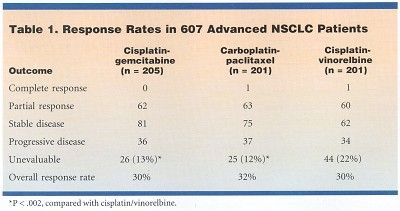Three Platinum-Based Doublets for NSCLC Tested in Italy
SAN FRANCISCO-Platinum-based chemotherapy with either gemcitabine (Gemzar) or paclitaxel (Taxol) caused fewer terminations of therapy for progressive disease or adverse events than the reference regimen of platinum with vinorelbine (Navelbine) in advanced non-small-cell lung cancer (NSCLC).
SAN FRANCISCOPlatinum-based chemotherapy with either gemcitabine (Gemzar) or paclitaxel (Taxol) caused fewer terminations of therapy for progressive disease or adverse events than the reference regimen of platinum with vinorelbine (Navelbine) in advanced non-small-cell lung cancer (NSCLC).
The study results were presented at the 37th Annual Meeting of the American Society of Clinical Oncology (ASCO abstract 1227).
Giorgio V. Scagliotti, MD, speaking for the Italian Lung Cancer Project, Obassano (Torino), Italy, said that the study protocol was based on phase II and III experience of the Italian Lung Cancer Project showing relevant activity in NSCLC for both gemcitabine and paclitaxel in combination with a platinum agent.
In addition, he said, phase III experience with a 3-week schedule of cisplatin (Platinol)/gemcitabine using two cisplatin doses (100 and 70 mg/m²) showed similar efficacy with both cisplatin doses but lower toxicity with the lower dose.
In this study, the investigators randomized 607 patients to receive cisplatin 75 mg/m² on day 2 and gemcitabine 1,250 mg/m² on days 1 and 8, every 3 weeks; carboplatin (Paraplatin) to AUC 6 on day 1 and paclitaxel 225 mg/m² on day 1, every 3 weeks; or cisplatin 100 mg/m² on day 1 and vinorelbine 25 mg/m² weekly for 12 weeks then every other week, given every 4 weeks.
Patients had stage IIIb disease (pleural effusion or N3 supraclavicular involvement) or stage IV NSCLC and were chemo-, radio-, and immunotherapy naïve. About 80% were stage IV, and about 8% had prior surgery.
Efficacy
Response rates were similar among the three treatment arms, Dr. Scagliotti reported, although there were significantly more unevaluable patients in the cisplatin/vinorelbine arm.

Median overall and progression-free survival were similar among the three arms.

Toxicity
Rates per cycle of grade 3-4 neutropenia were significantly higher for cisplatin/vinorelbine (23%/21%) than for cisplatin/gemcitabine (13%/3%) or carboplatin/paclitaxel (22%/12%).
Grade 3-4 thrombocytopenia was higher in the gemcitabine arm, although the rates were lower, Dr. Scagliotti said, than those seen in previous studies using a 4-week cisplatin/gemcitabine schedule. Grade 3 anemia was significantly less in the carboplatin/paclitaxel arm, as was the need for platelet and red blood cell transfusions.
In the cisplatin/vinorelbine arm, nausea, vomiting, and constipation were significantly higher, and there were more cases of febrile neutropenia (6 as opposed to 1 for cisplatin/gemcitabine and 2 for carboplatin/paclitaxel).
Dr. Scagliotti noted that the higher rate of cisplatin-related gastrointestinal toxicities in the vinorelbine arm were probably related to the higher cisplatin dose used (100 mg/m² vs 75 mg/m² in the gemcitabine arm).
Alopecia and peripheral neurotoxicity (including grades 2-3) were significantly higher in the carboplatin/paclitaxel arm.
Comparing the reference cisplatin/vinorelbine arm with the two experimental arms, Dr. Scagliotti said that significantly more cycles were omitted, more patients had dose reductions, fewer patients completed treatment, and more patients withdrew because of adverse events in the vinorelbine arm.
Progressive disease was a cause for termination of treatment in 95 cisplatin/vinorelbine patients, 80 cisplatin/gemcitabine patients, and 76 carboplatin/paclitaxel patients.
Selecting Treatment
In his conclusions, Dr. Scagliotti noted that overall response rate, overall survival, and time to progressive disease did not differ among the three arms.
Neutropenia (with clinically relevant laboratory findings) and gastrointestinal toxicity were significantly higher with the cisplatin/vinorelbine reference arm, he said. On the other hand, thrombocytopenia was significantly higher in the gemcitabine and paclitaxel arms, and alopecia and neurotoxicity were higher in the paclitaxel arm.
"Treatment of advanced NSCLC should still be based on clinically relevant toxicities, pharmacoeconomic considerations, and quality-of-life (QOL) issues (analysis pending for this trial)," Dr. Scagliotti said.
Newsletter
Stay up to date on recent advances in the multidisciplinary approach to cancer.